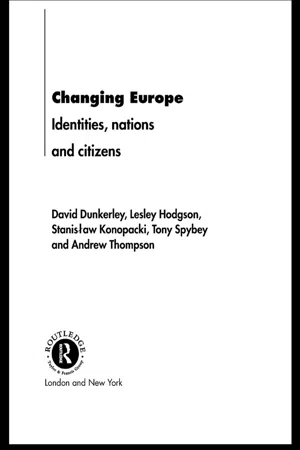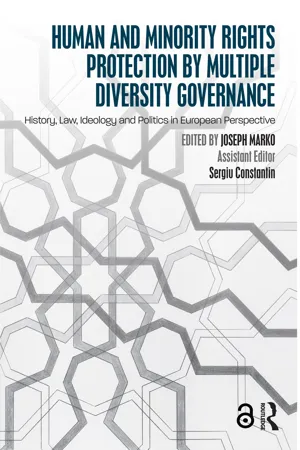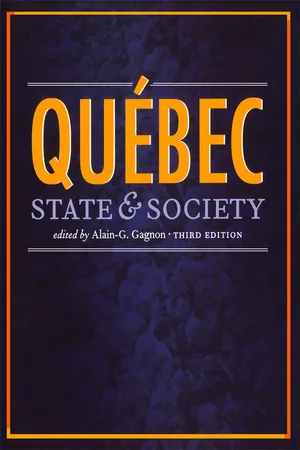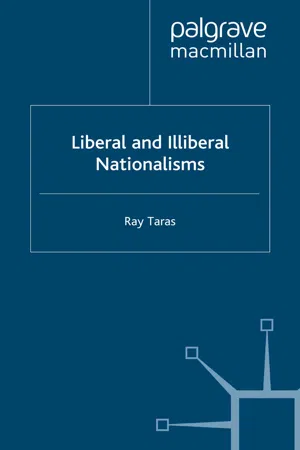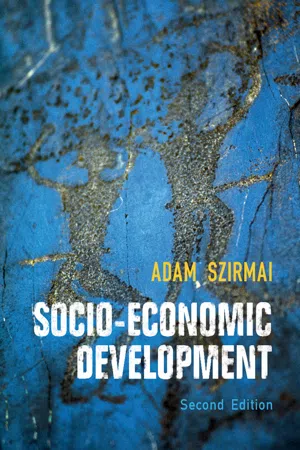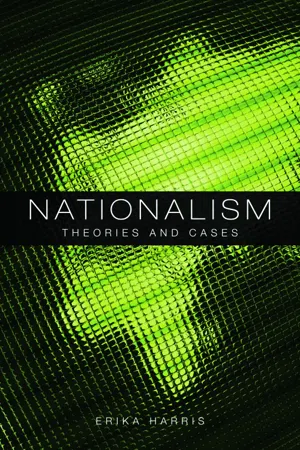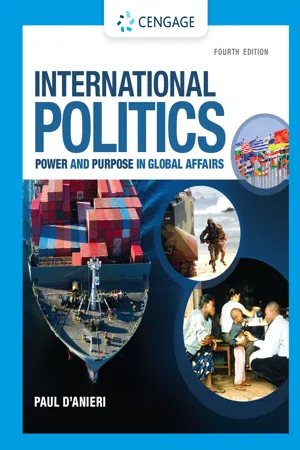History
Emergence of Nation States
The emergence of nation states refers to the process by which independent, unified political entities formed from smaller, fragmented territories. This development was marked by the rise of centralized governments, shared cultural identities, and defined borders. It played a significant role in shaping modern geopolitics and international relations.
Written by Perlego with AI-assistance
Related key terms
1 of 5
12 Key excerpts on "Emergence of Nation States"
- eBook - ePub
Changing Europe
Identities, Nations and Citizens
- David Dunkerley, Lesley Hodgson, Stanislaw Konopacki, Tony Spybey, Andrew Thompson(Authors)
- 2003(Publication Date)
- Routledge(Publisher)
The situation in the Balkans indicates that the ideal of the nation-state is one which many groups still consider to be worth fighting for. Elsewhere, numerous movements seek independent nation-states, while national governments continue to speak on behalf of ‘the nation’. Thus the idea of the nation-state arguably remains as appealing as it was two centuries ago. It is nevertheless becoming more difficult now for states to pursue the ideal of the cultural nation as they once did. In western Europe governments have increasingly promoted a civic version of the nation-state, in which citizens hold multiple identities; identifying, for example, with their ethnic group, their nation and/or with the wider polity of which they are citizens. This version of the nation-state has become a necessity in countries that have experienced considerable immigration, as well as perhaps increased demands for autonomy from ethnic and national minorities. In these cases governments have had to search for new ways of maintaining the unity of the nation-state. As we will see, however, in other countries the state has become firmly aligned with one ethnic group. For us, the important questions are whether we will see a movement away from the ethnic nation-state in Europe, and, if so, how will ‘the nation’ be defined in this context? Before considering the current and future prospects of the idea of the nation-state, we must understand the routes this idea has taken.The rise and transformation of the nation-state: 1700s to 1945Searching for the origins of the nation-state is something of a red herring; since pure nation-states do not exist, as noted above, it is not possible to identify when they came into being. As we have said, however, the idea of the nation-state has been enormously powerful in European political history, as governments and political movements have sought to convert the theory into practice. What we need to consider, then, is the nation-state as a process, rather than as an entity. We will therefore focus on three processes: the development of the national territory; the transformation of the state; and the building of popular identification with nation and state.Dimensions of change
With regard to territory there are two points we should make. The first is that it is broadly acknowledged that the significance of national frontiers has developed gradually, since the 1648 Treaty of Westphalia. This Treaty ended the Thirty Years’ Wars that had raged across much of Europe. Among the consequences of the Treaty, arguably the most significant was that it established the principle of sovereignty, thus recognising that sovereigns were the sole source of power within their territory and the representative of that territory in foreign affairs.The second point is that since this period the state has come to increasingly occupy the entire national territory. Until the late eighteenth century, and more particularly the latter part of the nineteenth century, the state made little impact on the mass of the population throughout the national territory. Navari (1981) argues that until the French Revolution monarchs made little attempt to effect centralisation throughout their realm. Indeed, she suggests, if they had it is very likely that various interested parties would have resisted such moves. Significant changes began to happen from the late eighteenth century onwards. The cumulative effect of change in post-Westphalian Europe was that the state increasingly came to occupy and, indeed, create - eBook - ePub
Human and Minority Rights Protection by Multiple Diversity Governance
History, Law, Ideology and Politics in European Perspective
- Joseph Marko, Sergiu Constantin, Joseph Marko, Sergiu Constantin(Authors)
- 2019(Publication Date)
- Routledge(Publisher)
section 2.2 ).Hence, the two processes of state formation and nation building are in empirical reality intimately interwoven, but must – for analytical purposes – be distinguished in order to be able to understand the transformation of social and political ordering from the medieval European political landscape referred to in the beginning to modern national states (see Max Weber’s definition in Chapter 2 , Box 2.2 ). This analytical distinction is necessary, because it is exactly the question and problem of the legal and empirical institutionalisation of the relationship between the concepts of state and nation and the different possible combinations which – defined as civic or ethnic model – determines the conceptual as well as the legal-institutional path-dependencies - eBook - PDF
Quebec
State and Society, Third Edition
- Alain G. Gagnon(Author)
- 2019(Publication Date)
- University of Toronto Press(Publisher)
Stateless Nations or Regional States? Territory and Power in a Globalizing World MICHAEL KEATING Beyond the Nation-State Recent years have seen a vigorous debate about the past, future, and present of the nation-state and about the emergence of new forms of order above, below, and alongside it. For some, the nation-state remains the fundamental unit of political and social order; for others, it is fading away; while others again argue that it is being transformed. The problem is that the nation-state is itself such a complex concept. Some observers put the emphasis on the nation part of the expression to claim that, given the plurality of most states, the expression is a misnomer. Others put the emphasis on the state part, using the expression as a synonym for a sover-eign actor in world politics. It is probably most useful not as a description of a state of affairs, but as an ideal type of political order, with which we can compare regimes past, present, and future. Taken in this way, the key features of the nation-state are its internal and external sovereignty and its ability, within its territorial borders, to contain a range of social, political, economic, and cultural systems. Nation-states have often defined national cultures, in the process making a nation out of the state. They have defined the citizenry, who are the only ones endowed with full civil and political rights, and who comprise the demos underlying democracy. They create, define, and sustain political institutions, including systems of representation and accountability. Finally, they define and regulate a series of functional systems, in 391 19 392 Quebec: State and Society the economy, social integration, and other forms of regulation. These are, in the ideal type, linked to each other so that social solidarity is sustained by a common identity and common norms. This in turn facilitates the production of public goods and handles the externalities that could otherwise hamper economic development. - eBook - PDF
- R. Taras(Author)
- 2002(Publication Date)
- Palgrave Macmillan(Publisher)
. . . It emphasized the rights of govern- ment, and so intensified the process of unification in nation states which were already set in that path; but it also militated against the develop- ment of the process where different political entities prevailed, as in the petty states of Germany and Italy, or the great dynastic empire of the 26 Liberal and Illiberal Nationalisms Habsburgs. The process of formation of nation states therefore experi- enced a setback at the end of the Middle Ages, from which it did not recover until the nineteenth century. 65 Without the glow of religious or nationalist sentiment the state was a `cold monster'. The state began to emancipate itself from the church, leading to a depoliticization of religion and, related to this, an end to the threat of renewed religious wars. Raison d'etat ± the interests of the state ± formed the rationale for state actions. In an effort to impose some order on the emergent state system, Hugo Grotius elucidated an early version of international law. 66 In his influential book Imagined Communities, Benedict Anderson high- lighted the contrast between the murky contours of the state before the seventeenth century and its status today: In the modern conception, state sovereignty is fully, flatly, and evenly operative over each square centimetre of a legally demarcated territory. But in the older imagining, where states were defined by centers, borders were porous and indistinct, and sovereignties faded imperceptibly into one another. Hence, paradoxically enough, the ease with which pre-mod- ern empires and kingdoms were able to sustain their rule over immensely heterogeneous, and often not even contiguous, populations for long periods of time. 67 With the Westphalia peace, etatism crowded out nationalism, the dynasty took the place of religion, and loyalty was transferred to the prince. The state became the maker of nations and national identities, not the other way around. - eBook - PDF
- Philip van Praag(Author)
- 2017(Publication Date)
- Amsterdam University Press(Publisher)
3 Nations, Nationalism and the Nation State Luuc Brans, Theresa Kuhn and Tom van der Meer 3.1 Introduction In his classic work, Nations and Nationalism, sociologist Ernest Gellner (1983: 6) wrote that we are so used to the idea of nations that we simply cannot imagine a world without them. Nations, nationalism and nation states have become a vital part of modern politics, and are invariably the subject of social and scholarly discussions. Just think of the election campaign of US president Donald Trump – America First – or of the slogans and names of right-wing populist parties, particularly in Western Europe, such as True Finns, the (French) National Front, Proud of the Netherlands, and Flemish Interest. In 2017, the Dutch and Turkish governments got into a spat during the campaign season about the loyalty and dual nationality of Dutch citizens of Turkish origin. In the wake of the European sovereign debt-crisis (2011-2014) and in the Brexit referendum (2016), lacking feeling of community of fate challenged solidarity within the European Union. So what is a nation anyway, and when did nations arise? What are the dif ferent traditions of nationalism we can distinguish? Is there such a thing as a nation state, and, if so, is it under pressure these days? Historians have been debating questions like these since the nineteenth century. Since World War II, the nation, and the nationalism linked to it, have also been an important object of study for the social sciences. With the end of com-munism in Central and Eastern Europe, the attimes genocidal nationalism during the wars of secession in the former Yugoslavia, and the emergence of new political movements in Western Europe in response to migration and Europeanisation, the discussion has continued to be relevant and has remained the focus of attention. At the same time, the main concepts themselves – collective identity, nation, nationalism, and nation state – have been discussed since the nineteenth century. - eBook - PDF
- Adam Szirmai(Author)
- 2015(Publication Date)
- Cambridge University Press(Publisher)
In the nineteenth century, nationalism was one of the driving forces in colonial expansion. In the twentieth century, modern nationalism – the idea that all peoples or nations are entitled to their own independent states – was to be an important force in the colonial struggles for independence from Western colonisers. European processes of state formation have a number of speci fi c characteristics, which distinguish them from processes of state formation in other parts of the world. First, centralisation did not emanate from one single centre, but from various focal points within Europe. Second, centralisation never led to the establishment of an all-embracing European empire. Parallel processes of centralisation resulted in a multitude of national states, competing with each other for technological advance, military supremacy and economic and political expansion. Third, the resulting European states were strong and effectively centralised, compared to larger but more loosely organised political entities such as, for instance, the Chinese empire. Finally, rising bourgeois groups, who were the bearers of a money and market economy, had a relatively independent position. They were never completely subordinated to a central political authority, as was the case in the great empires of the past. In the competition between states, political leaders actually depended in part on the support of their entrepreneurial classes. These classes supported the new strong states in their fi nancial needs and their competition with other states. The states in turn supported their entrepreneurial groups in their urge for external economic expansion. Initially, the European expansion in the world was economic rather than political in nature. - eBook - PDF
- Henri J. M. Claessen, Peter Skalnik, Henri J. M. Claessen, Peter Skalnik(Authors)
- 2011(Publication Date)
- De Gruyter Mouton(Publisher)
2 State Origins: A Reappraisal 1 R O N A L D C O H E N 1. INTRODUCTION Give or take a few multi-national corporations, the state is the most powerful, continuously authoritative, and most inclusive organization in the history of the species. Even a relatively small and weak state has the universally acknowledged right, if it wishes, to expropriate holdings of the largest and most powerful multi-nationals in the world. Evolu-tion doesn't stop of course; imperialism, groupings of nations, and actual federations may develop on the way to global political and social organization (Naroll 1967). For now, however, and for the forseeable future true sovereignity stops with national state boundaries so that these units remain the largest scaled political organizations that con-tinuously act and react as corporate entities on the world scene. How and under what conditions such powerful and ubiquitous structures evolve has fascinated scholars for a long time. So far, however, many of the major theoretical thrusts have been based on lack of agreement about what a state is, about what it does, why or how it develops, and what utility, if any, it has for its members. This in turn stimulates the well-known cacaphony of academic voices in which researchers from differing traditions speak past each other to 'true believers' in their own specialties, or of their own ideological persua-sion. This essay attempts to go beyond such polemics and commit-ments to an examination of factors clearly associated with state found-ation. My goal is to assess some modest generalizations that provide a synthesis of present views rather than heightening the enthusiasm of adversaries or previously enshrined positions and disagreements. In what is to follow I shall discuss the definitional problem and then examine in turn ecological and demographic factors, external relations, 32 Ronald Cohen internal organization, and finally cultural factors associated with the rise of early states. - eBook - PDF
Global Forces and State Restructuring
Dynamics of State Formation and Collapse
- M. Doornbos(Author)
- 2006(Publication Date)
- Palgrave Macmillan(Publisher)
1 Dynamics of State Formation and Collapse, Past and Present Introduction While in recent years crises in and about states have seemed to multiply across the globe, governance crises are essentially of all times. In ancient as well as in more recent history, misgivings about the manner of wield- ing political power have frequently caused a decline of trust in prevail- ing political arrangements, inviting conflict and searches for alternative ways of organizing politics. At least in this respect, history will never end. But the very recurrence of such issues appears to call for some historical–comparative reflection on processes of state formation, crisis and collapse and on the connections between power and identity that so often play a role within these dynamics. As times change, the way the issues present themselves may illuminate different aspects, open up new perspectives and allow novel connections and comparisons to be explored. Thus, in political anthropology in recent years one area of research has been stimulated by intellectual curiosity in the conditions of early state formation – early in the sense of ‘first-ever’, usually ancient (Carneiro 1987, Claessen 2000, Harris 1978, Service 1975). Numerous aspects of political and social organization, economic resource bases, cultural attributes and others have in this connection been examined on their possible causal effects on the emergence of the first forms of state- hood. Naturally, one has also discovered that in many if not most of such contexts, state formation was not anything like a linear process but came with numerous set-backs, prolonged stalemates, occasional break- throughs and yet, perhaps, a gradual building up of a social and eco- nomic basis conducive to or calling for the emergence of a kind of state form (Claessen 2000). 1 - eBook - PDF
Globalization and the Nation State
2nd Edition
- Robert J. Holton(Author)
- 2011(Publication Date)
- Red Globe Press(Publisher)
This is obviously a hybrid word, linking the idea of ‘nation’ with the idea of ‘state’. While the former refers to what might loosely be termed a ‘people’ – that is, to a cultural entity often defined in terms of ethnicity – the latter refers to a set of institutions through which public authority is exercised within a particular bounded territory. Although the connection between the two is conventionally regarded as a necessary one, this is largely a reflection of the formative experience of European nation state building, founded on the normative concept of rights to national self-determination. This has helped, first in Europe and later in the colonial world, to legitimate the idea of ‘one people – one state’. This normative principle is not, however, reflected in the basis of many existing nation states, which, for one reason or another, contain a mixture of peoples or ethnicities. (For further elaboration, see Chapter 6.) In such cases, the identity of the nation has often become a matter for dispute and, sometimes, national fragmentation. Even in such instances, however, the nation state is more than a state apparatus, requiring that attention be given to the intersection of politics, culture and economic change. If the nation state is thought of in this dual or hybrid sense, then the question of the relationship between nation states and globalization becomes larger and more complex. Two large issues stand out. The first 98 Globalization and the Nation State is the challenge of maintaining state sovereignty in relation to the cross-border character of the global economy and global regulatory processes. The second problem, that of the national integrity of a people, brings into focus questions of political and cultural identity. - eBook - PDF
Nationalism
Theories and Cases
- Erika Harris(Author)
- 2009(Publication Date)
- EUP(Publisher)
16 This is not very reassuring in our time of ethnic conflicts, rising religious fundamentalism and attempts at a less national understanding of humanity and its needs. Many questions remain unanswered in this largely historically accurate account of nation formation. If ethnies have a historical role to play in the formation of nations, what comes after nations? Should their relevance decline as some observers would argue is already in evidence? If ethnie will inevita-bly become a nation, is the process of disintegration of multi-ethnic states (nearly all states) endless? What is the role of external factors in this ethnically essentialist account? The relevance of these ques-tions will become more apparent throughout chapters 3 to 7. A constructed nation? The modernist approach Smith provides us with one of the most comprehensive definitions of nationalism as ‘an ideological movement for the attainment and maintenance of self-government and independence on behalf of a group, some of whose members conceive it to constitute an actual or potential ‘nation’’. 17 In reluctant acceptance of modernity, or rather the relevance of the political element in the rise of nations, the nation, is defined by Smith as ‘a group of human beings, pos-sessing common and distinctive elements of culture, a unified economic system, citizenship rights for all members, a sentiment of solidarity arising out of common experience, and occupying a common territory’. 18 Smith was a student of Ernest Gellner who personifies the modernist school of nationalism. Gellner’s best-known maxim asserts that ‘nationalism is not the awakening of nations to self-consciousness: it invents nations where they do not exist’. 19 If nationalism ‘engenders nations’ 20 and nationalism is a modern ide-ology that can be dated only as far back as the French Revolution, then nations are novel and not the culmination of the existence of ethnie . A considerable space has been given to the role of ethnie in - No longer available |Learn more
International Politics
Power and Purpose in Global Affairs
- D'Anieri, Paul D'Anieri(Authors)
- 2016(Publication Date)
- Cengage Learning EMEA(Publisher)
Copyright 2017 Cengage Learning. All Rights Reserved. May not be copied, scanned, or duplicated, in whole or in part. Due to electronic rights, some third party content may be suppressed from the eBook and/or eChapter(s). Editorial review has deemed that any suppressed content does not materially affect the overall learning experience. Cengage Learning reserves the right to remove additional content at any time if subsequent rights restrictions require it. 46 INTERNATIONAL POLITICS: Power and Purpose in Global Affairs by Europe. New states were formed, their borders were demarcated, and they were rec-ognized as sovereign through membership in the UN. Possessing a sovereign state was the central goal of most nationalist movements, but integration of decolonized territory into the state system was fraught with difficulty. The sovereign state system is based on a strict territorial division of political authority. Borders had to be drawn in regions where they had not existed, in a formal sense, prior to colonialism. In many cases, borders that had served the interests of colonial administrators became the borders of new states. This created problems within countries, such as Iraq, and between countries, such as India and Pakistan, that persist today. Many of the new states were not “nation-states” at all, but included multiple ethnic, linguistic, and national groups, and some groups found them-selves spread across two or more states. The transition of colonies into sovereign states after World War II meant that the Westphalian state system, after 500 years of expansion and evolution, now covered almost the entire territory of the planet outside Antarctica. Many leaders of newly decolonized states rejected the idea that they should choose sides in the Cold War. Leaders in most of these countries were much more interested in economic development. - eBook - PDF
Nationalism, Myth, and the State in Russia and Serbia
Antecedents of the Dissolution of the Soviet Union and Yugoslavia
- Veljko Vujačić(Author)
- 2015(Publication Date)
- Cambridge University Press(Publisher)
This striving for territorial political power on the basis of a shared culture was central to the notion of the nation: Time and again, we find that the concept of the “nation” leads us to political power. Hence, the concept seems to refer – if it refers at all to a uniform phenomenon – to a specific kind of pathos which is linked to the idea of a powerful political community of people who share a common language, or religion, or common customs, or politi- cal memories; such a state may already exist or it may be desired. The more power is emphasized, the closer appears to be the link between nation and state. 17 14 Weber, Economy and Society, vol. II, p. 922. 15 For the classic statement of sociological conflict theory in terms of in-group and out-group dynamic, see Lewis Coser, The Functions of Social Conflict (New York: Free Press, 1956). 16 Linda Colley, Britons: Forging the Nation, 1707–1837 (New Haven: Yale University Press, 1992). 17 Weber, Economy and Society, vol. I, p. 398. This idea precedes Gellner’s definition of national- ism as a “political principle which holds that cultural and political boundaries should coincide.” See Ernst Gellner, Nations and Nationalism (Ithaca: Cornell University Press, 1983), p. 1. I. Max Weber on Nations, Nationalism, and Imperialism 55 It is important to recognize, however, that for Weber the concepts of nation and state did not belong to the same plane of sociological reality. Whereas the existence of the nation was predicated upon feelings of cultural solidarity shaped by shared memories and political experiences, the state was “an asso- ciation developed consciously for specific purposes.” Consequently, the nation was a community of affective ties, that is, a gemeinschaft-type phenomenon; the state, by contrast, was a rational political association, a gesellschaft-type phenomenon.
Index pages curate the most relevant extracts from our library of academic textbooks. They’ve been created using an in-house natural language model (NLM), each adding context and meaning to key research topics.
